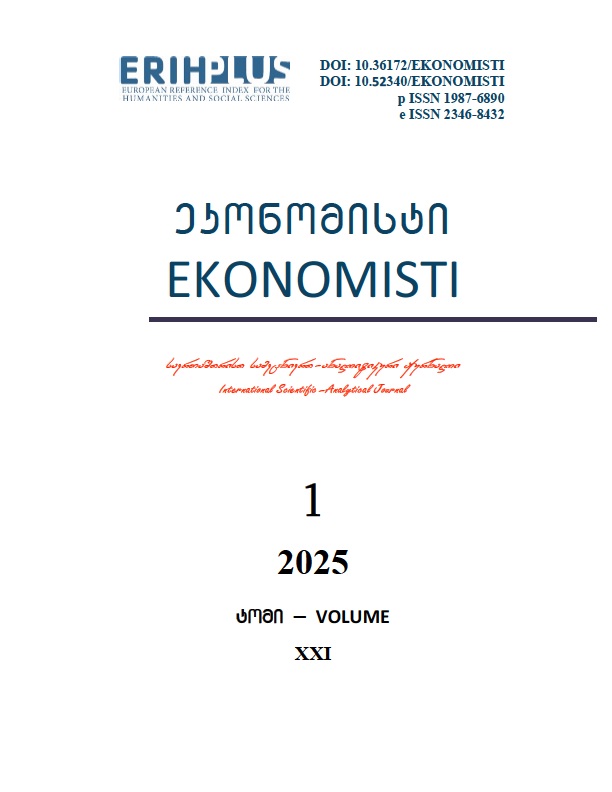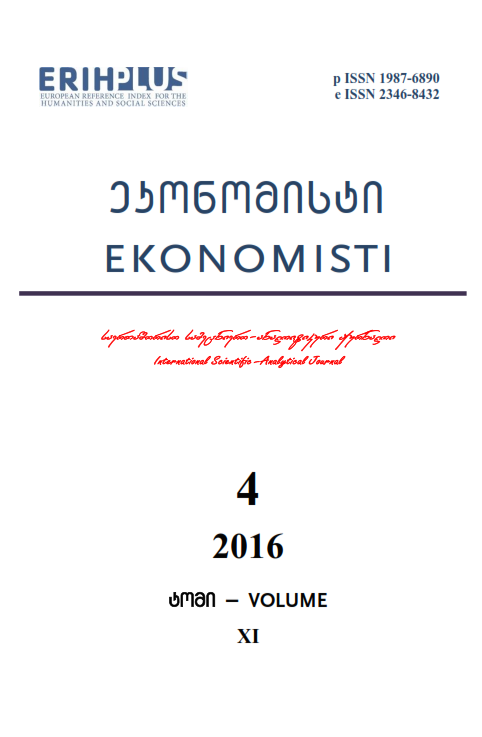
The international scientific and analytical, reviewed, printing and electronic journal of Paata Gugushvili Institute of Economics of Ivane Javakhishvili Tbilisi State University

The role of the framework of economic order in the development of business environment in Visegrad countries
Expanded Summary
The objective of economic success is not only to achieve positive developments in economic indicators, but to ensure a high living standard and quality of life for the population. It is therefore necessary to measure economic success in terms of social and socio-economic indicators, which indicate the quality of life of the population. A relevant indicator of economic development and economic performance is the gross domestic product (GDP) per capita. Although this indicator is the most widely used, it has recently been subject to a wave of criticism. Therefore it is necessary to evaluate the economic success, taking into account other variables, which in themselves imply social indicators: net economic welfare, Human Development Index (HDI), Index of Competitiveness, Index of Economic Freedom (IEF), Prosperity Index, Corruption Perception Index and others. The subject of this article is to evaluate the economic performance of the Visegrad Group countries using GDP per capita and selected socioeconomic indicators. We use the method of time series analysis to examine the development of selected indicators. To compare their development we use the method of comparison, and to formulate the findings we use the method of synthesis. In order to evaluate the performance of the Visegrad countries we use scoring method.
Gross domestic product (GDP) is considered as an essential economic indicator because it best represents the performance of an economy based on the outcome of production factors located in the national territory. This indicator best characterises the processes occurring in the economy, as well as its overall performance (i.e., what was produced and purchased in the economy), and thus it affects all other macroeconomic variables. On the other hand, against GDP as a dominant indicator for several decades, there has been developing research aimed at criticism of GDP, as well as construction of alternative (additional) indicators that would better reflect the aggregate performance of economic and social system. Therefore, it is adequate to understand the term ‘performance’ from a wider aspect, i.e., the GDP to be used to assess the performance of state in combination with other alternative indicators, which reflect the socio-economic aspects of society development and quality of life of population in society. We agree with the authors Vojtovič and Krajňáková (2014) that the GDP intended for final production assessment cannot be expected to measure and assess all other aspects of life. For a more accurate and detailed assessment of society’s performance and well-being it is appropriate to use a combination of several indicators taking into account other aspects of society functions. In professional literature there are alternative indicators regarding how to measure economic performance such as: net economic welfare, real economic development, Human Development Index (HDI), Index of Human Suffering, Index of Economic Freedom (IEF), Well-being Index and the Global Competitiveness Index (GCI), among others. There are advantages and disadvantages while using the GDP to measure the performance of economy.
The availability of statistical data necessary for its assessing national territories is a positive aspect of its use. Kordoš (2012) argues that based on the state and development of a country’s GDP, the overall economic activity on the State’s territory as well as the economic success of states in international comparisons can be best evaluated, since most countries of the world use GDP to assess their performance. Due to the objective performance comparisons of different sized economies, the GDP per capita in USD, EUR or PPP is used for international comparisons. On the other hand, not forgetting the fact that many economists do not consider GDP to be a perfect indicator, it does not reflect the well-being and living standards of state citizens. It only includes production and services registered by the official economy, although the results of domestic work and grey and black economy often significantly affect increases, respectively reducing the welfare of the population. GDP also includes outputs which are not subject to purchase and sale (services of education, health, defence). Since these services are not executed on the market they do not have their market prices, however the costs of their provision are included in GDP. Another negative example is the fact that the cost of environmental damage and natural disasters removal are included in the prices of products and services which increases the GDP, however the environmental pollution reduces the welfare of people. The paradox is that the serious damage removal caused by natural disasters or wars can be a source of economic growth. Another drawback of this indicator is that the price increases as a result of using unnecessarily expensive materials or packages, based purely on aesthetics. This causes GDP growth, although the utility value of those products may not be growing. On the contrary, in the case of some products (e.g., electronics) their quality substantially increased but, despite this, their prices were falling, so the increasing quality of those products does not contribute to the GDP growth. Van der Bergh (2009) argue that GDP suffers from many serious shortcomings, but despite all theoretical- and empirically-motivated criticisms of GDP as a social welfare and progress indicator, its role in economics, public policy, politics and society remains influential. We cannot ignore that GDP is also affected by many other factors. Some authors in their research have been assessing the impact of these factors on GDP. Lučić, Radišić, and Dobromirov (2016) explored the causality between corruption and the level of GDP. Trošt and Bojnec (2015) showed the causality between public wage bill, exports and economic growth in Slovenia. Yu and Wang (2013) examined political risk and economic development (GDP per capita). Nurazira, Dauda, Halim Ahmad, and Azman-Saini (2013) was analysing the contribution of external debt to economic growth in Malaysia. Simionescu, Popescu and Firescu (2017) recognised the relationship between GDP and monetary variables in Romania. Ivanović and Stanišić (2017) studied the monetary freedom and economic growth in New European Union Member States. Novak and Pahor (2017) explored the influence of economic development on the subjective well-being of individuals. Internationally established commission, whose results are included in so called Stiglitz report (Stiglitz, Sen, & Fitoussi, 2010) dealt with this professionally discussed topic. It includes following objections to GDP:
• Items counting into GDP – GDP includes mainly market production only a small part of nonmarket output, because it is an indicator of overall economic performance.
• Problem of depreciation – GDP estimation does not take into account the extent of capital goods recovery. • Education and health care – estimated value of public goods, health care and education does not exist, GDP does not reflect value of such services. In international comparisons a service can be provided as a public good as well as a private good.
• Problem of qualitative changes capturing – inflation distinction from qualitative changes in goods and services is considered to be a complex statistical problem.
• GDP does not reflect the state of environment – to identify environmental impacts on economic growth in society can be done by the System of Environmental and Economic Accounting (SEEA), which is a satellite system of SNA (System of National Accounts). Environmentally adjusted GDP takes into account costs associated with natural resources exploitation, pollution and environmental degradation.
National leaders are trying to carry out an economic policy that would lead to higher the performance of a country and the living standard of citizens. Economic performance and standard of living it is relatively difficult to measure because there is no indicator for their unambiguous quantification. GDP appears to be the most used indicator to measure the economic performance in theory and practice. However, for a long time in professional circles a criticism has been growing about the GDP indicator, this resulted in Stiglitz report. However, despite this criticism, it still remains the decisive indicator regarding how to assess the economic performance of countries. The Stiglitz report recommends more focus on assessing the level of social welfare and environmental aspects, as high GDP does not automatically mean a successfully-working economy and a satisfied society. In connection with the GDP indicator criticism, many parameters (indexes) have been created worldwide trying to replace the GDP or for it to be supplemented with other aspects of well-being. Because individual indicators evaluate various aspects of performance and social life, even results within countries are different. The goal of our research was to comprehensively assess the performance of the Visegrad Group countries by means of using the results of these countries in indicators such as: GDP per capita, HDI, GCI and IEF. Within the V4 countries regarding the macroeconomic indicators assessment, the Czech Republic is the most successful, it scored the highest values during the whole observed period in the GDP per capita indicator (current price, euro per capita), in the HDI and also the GCI, except in 2013. Regarding the assessment of GDP growth, the Slovak Republic had relatively positive development, especially in 2005–2008 when it reached the highest values within the V4 countries; Hungary also achieved this in 2013 and 2014. In the crisis year (2009) all countries showed a significant decline in economic growth, except Poland, which has maintained positive figures. The Czech Republic also reached the best values in the indicator of global competitiveness, except in 2013, when Poland scored the best values. The worst development in this indicator can be seen in Slovakia; in 2013 there was a big drop in the Slovak Republic. Within the IEF from 2005 till 2014, the best assessment was scored by Slovakia and the Czech Republic, in 2015 it was Poland. The complex assessment of the V4 countries economic performance has been implemented by means of a scoring method. The scoring method was considered as an appropriate method because it can be applied to assessment of both quantitative and qualitative criteria, being expressed by the number of points from the selected scoring track. Based on the scoring method results, we note that within the V4 countries Czech Republic is the most successful country in terms of indicators being assessed when in 2010–2014 the Czech Republic reached the highest values in all tested indicators, i.e., the value of integral indicator has reached 400 points. The second notch belongs to the Slovak Republic; its performance has been approaching year by year the level of the Czech Republic.
The assessment values of Hungary and Poland are relatively balanced. Since 2012 Poland has achieved a higher rating than Hungary. Globally we can say that the differences in the V4 countries’ economic performances are being narrowed; the gap between the other V4 countries and the Czech Republic in observed period has become smaller. We realise that the scoring method as a multicriteria method guarantees a certain degree of objectivism, but also it has some pitfalls arising from the subjectivism, which relates to the selection of evaluated indicators, that do not have to reflect the full economic performance and social progress of a country. In further research in this area we want to focus on the countries’ performance assessment being based on a broader range of indicators and on the assessment of dependency between the GDP indicator and the alternative indicators to GDP (HDI, GCI, Index of Prosperity, IEF, but also employment and population income.)

